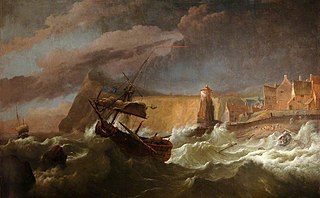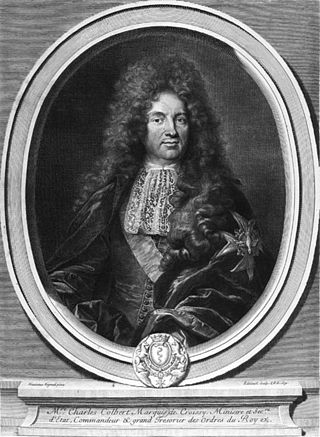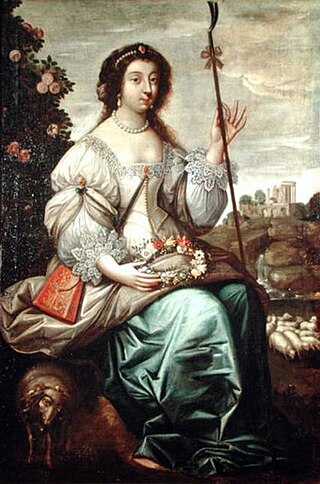
Charles d'Angennes, marquis de Rambouillet (1577 - Paris, 26 February 1652) was a French noble and diplomat.

Charles d'Angennes, marquis de Rambouillet (1577 - Paris, 26 February 1652) was a French noble and diplomat.
He was the only son of Nicolas d'Angennes and Julienne d'Arquenay.
He became lord then marquis of Rambouillet (1612) and Pisani, Baron de Talmont, Lord of Arquenay, Vidame & Sénéchal du Mans, captain of the 2nd company of the Hundred Gentlemen of the Household of the King. In 1610 he was appointed Grand Master of the King's Wardrobe and a Knight in the Order of the Holy Spirit (1619). He was also State Councilor, Colonel-General of the Italian Infantry (1620) and Maréchal de camp (1620).
Appointed Ambassador of France to Italy, he negotiated in 1614 and then in 1615, during the War of the Montferrat Succession, the first and second peace treaties between Louis XIII and the Duke of Savoy. In 1627 he was sent as extraordinary ambassador to Piedmont and Spain. [1]
In 1600 he married Catherine de Vivonne, who became an important society hostess and a major figure in the literary history of 17th-century France. They had 7 children:

1691 (MDCXCI) was a common year starting on Monday of the Gregorian calendar and a common year starting on Thursday of the Julian calendar, the 1691st year of the Common Era (CE) and Anno Domini (AD) designations, the 691st year of the 2nd millennium, the 91st year of the 17th century, and the 2nd year of the 1690s decade. As of the start of 1691, the Gregorian calendar was 10 days ahead of the Julian calendar, which remained in localized use until 1923.

Charles de Sainte-Maure, duc de Montausier, was a French soldier and, from 1668 to 1680, the governor of the dauphin, the eldest son and heir of Louis XIV, King of France.

Catherine de Vivonne, marquise de Rambouillet, known as Madame de Rambouillet, was a society hostess and a major figure in the literary history of 17th-century France.

The Hôtel de Rambouillet, formerly the Hôtel de Pisani, was the Paris residence of Catherine de Vivonne, marquise de Rambouillet, who ran a renowned literary salon there from 1620 until 1648. It was situated on the west side of the rue Saint-Thomas-du-Louvre, just north of Marie de Rohan's Hôtel de Chevreuse, in a former quarter of Paris, located between the Louvre and Tuileries palaces, near the then much smaller Place du Carrousel, in the area of what was to become the Pavillon Turgot of the Louvre Museum.

Charles Colbert, Marquis of Croissy was a French statesman and diplomat.

Simon Arnauld de Pomponne, Seigneur and then Marquis (1682) of Pomponne was a French diplomat and minister.

The Guirlande de Julie is a unique French manuscript of sixty-one madrigaux, illustrated with painted flowers, and composed by several poets habitués of the Hôtel de Rambouillet for Julie d'Angennes and given to her on her name day in May 1641. The 1641 manuscript was bought by the Bibliothèque nationale de France in 1989 and is now kept in the Département des Manuscrits of the BnF.

The Gardes du Corps du Roi was the senior formation of the King of France's household cavalry within the maison militaire du roi de France.
Charles François d’Angennes, Marquis de Maintenon was a French nobleman who became a buccaneer in the Caribbean. He sold the Château de Maintenon, his ancestral estate, to Madame de Maintenon, the second wife of King Louis XIV of France.

The Château de Maintenon is a château, developed from the original castle, situated in the commune of Maintenon in the Eure-et-Loir département of France. It is best known as being the private residence of the second spouse of Louis XIV, Madame de Maintenon.
François Dominique de Barberie de Saint-Contest was a French Foreign Minister.
Pierre Brûlart, Lord of Genlis and Crosne was a French statesman of the sixteenth century.

Julie d'Angennes, Duchess of Montausier was a French courtier. She served as royal governess of Louis, Grand Dauphin in 1661–1664, and Première dame d'honneur to the queen of France, Queen Marie Thérèse, from 1664 until 1671.

Catherine de Mayenne, or Catherine de Mayenne-Lorraine-Guise, was a French aristocrat.

Nicolas d'Angennes, sieur de Rambouillet was a French noble, governor, diplomat and soldier during the French Wars of Religion. The son of Jacques d'Angennes and Isabelle Cottereau, Rambouillet rose fast during the civil wars. In 1568, he was made a chevalier de l'Ordre de Saint-Michel and governor of Maine. In this period he served as a diplomat for the French crown, being given a mission to travel to England. With Anjou, the brother of the king's, election as king of the Commonwealth in 1573, he was dispatched as Anjou's vice-roi to the Commonwealth court in Kraków to thank the senate for his election, and prepare the way for his lord. Upon Anjou's arrival, he would be selected as the main conduits between the French court in the country and the local aristocracy. Tiring of the court, he departed back to France, only to again find himself on a mission to the Commonwealth, to inform Anjou that he was now king of France.

Louis d'Angennes, seigneur de Maintenon was a French noble, diplomat, governor and soldier during the French Wars of Religion. The son of Jacques d'Angennes and Isabelle Cottereau, he first achieved prominence in 1568, when he was established as governor of Le Mans. He reinvigorated the cities Catholic ligue for a fight against Protestantism. At that time he became grand maréchal de logis de la maison du roi, a post he would hold until 1579. He fought for the crown during the brief seventh civil war at the Siege of La Fère. In 1580 he was established as one of the king's Chambellan. The following year he would be elevated to the most senior order of French chivalry, being among the 1581 intake as a Ordre du Saint-Esprit. He and his brother Rambouillet participated in the Assembly of Notables that sought to consider a financial reform package from 1583-1584. His selection to participate in the Estates General of 1588 was forced through by the king over the objection of the governor of Chartres who had hoped to select a less royalist delegate. At the Estates, when word arrived that the duke of Savoie had invaded French held Saluzzo he whipped the Second Estate into a patriotic fervour with a speech advocating first the recapture of Saluzzo, and then the declaration of war against Spain. However the ligueur members of the other States got the nobility back into line, and his plan went nowhere.

François de La Rochefoucauld, 1st Duke of La Rochefoucauld was a French nobleman. He was the father of François de La Rochefoucauld author of Réflexions ou sentences et maximes morales better known as the Maximes.

Emmanuel II de Crussol, 5th Duke of Uzès, was a French soldier, diplomat and courtier. He fought in Hungary against the Turks during the Austro-Turkish War, then in the Rhineland during the Third Anglo-Dutch War. He also served as governor of Saintonge and Angoulême.
François de Crussol, 4th Duke of Uzès, was a French soldier and courtier.

Jacques d'Étampes, 1st Marquis of La Ferté-Imbault and Mauny, was a French soldier created Marshal of France during the reign of King Louis XIV. He also served as the French Ambassador to England from 1641 to 1643.